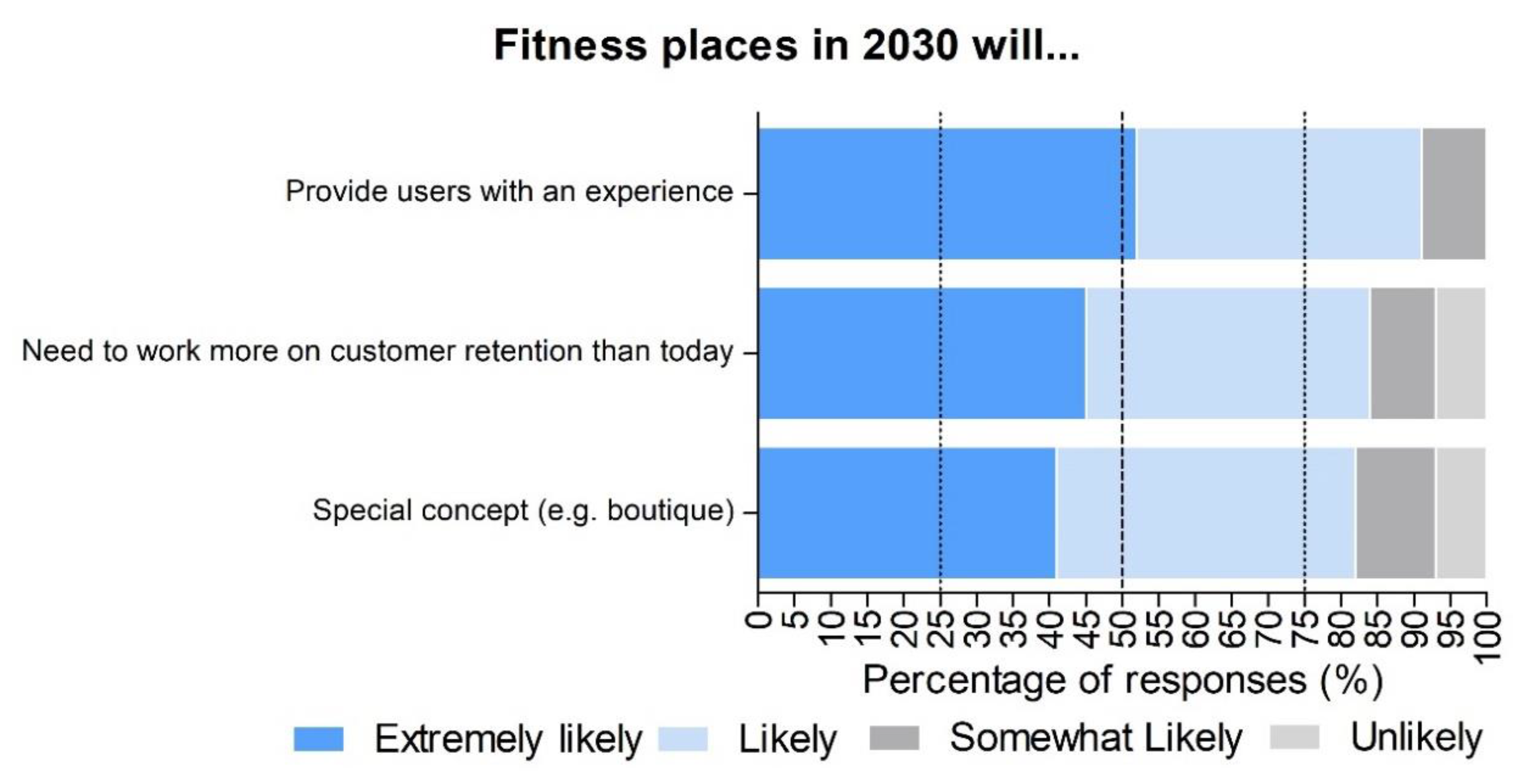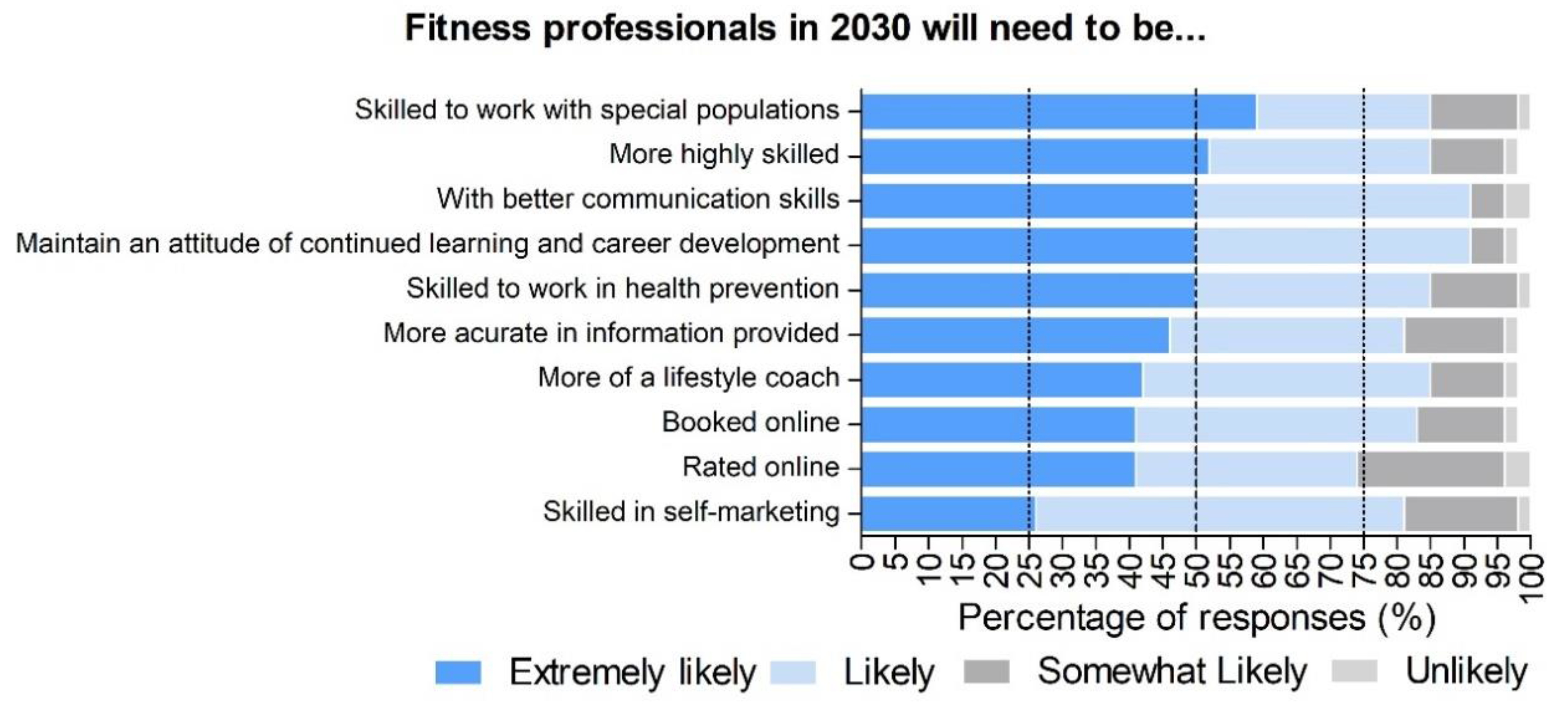Foresight for the Fitness Sector: Results from a European Delphi Study and Its Relevance in the Time of COVID-19
Abstract
1. Introduction
2. Materials and Methods
2.1. Design
2.2. Sampling
2.3. Data Collection
2.3.1. Brainstorming
2.3.2. Online Survey
2.3.3. Validation
2.4. Data Analysis
3. Results
3.1. Main Drivers for Change and Development in the European Fitness Market Over the Next Decade
3.2. Characteristics of Fitness Places Over the Next Decade
3.3. Skills of Fitness Professionals Over the Next Decade
4. Discussion
5. Conclusions
Author Contributions
Funding
Acknowledgments
Conflicts of Interest
References
- World Health Organisation. Global Action Plan on Physical Activity 2018–2030. At a Glance. 2018. Available online: https://apps.who.int/iris/bitstream/handle/10665/272721/WHO-NMH-PND-18.5-eng.pdf (accessed on 18 November 2020).
- World Health Organisation. Physical Activity Strategy for the WHO European Region 2016–2025; World Health Organisation: Geneva, Switzerland, 2015. [Google Scholar]
- Deloitte. European Health & Fitness Market Report 2019; Deloitte: London, UK, 2019. [Google Scholar]
- Jimenez, A.; Berriman, J.; Collins, C.; Thienemann, E.; Szumilewicz, A.; Smulders, H. The Relevance of the Active Leisure Sector and International Qualification Framework to the EQF (SIQAF): Final Report; EuropeActive: Brussels, Belgium, 2018. [Google Scholar]
- Cedefop. Skills-OVATE: Skills Online Vacancy Analysis Tool for Europe. Available online: https://www.cedefop.europa.eu/en/data-visualisations/skills-online-vacancies (accessed on 20 October 2020).
- EuropeActive. European Employers Skills Survey 2019; EuropeActive: Brussels, Belgium, 2019. [Google Scholar]
- Active Leisure Alliance. Home. Available online: https://www.active-leisure-alliance.eu (accessed on 4 November 2020).
- Council of the European Union. European Alliance for Apprenticeships. Council Declaration. 14986/13; Council of the European Union: Brussels, Belgium, 2013. [Google Scholar]
- EuropeActive. Blueprint for Skills Cooperation and Employment in Active Leisure. Available online: https://www.europeactive-euaffairs.eu/projects/blueprint (accessed on 18 November 2020).
- Thienemann, E.; Lapeyrère, J.-Y. Skills Foresight (Research) in the Active Leisure Sector; EuropeActive: Brussels, Belgium, 2020. [Google Scholar]
- Hsu, C.-C.; Sandford, B.A. The Delphi Technique: Making Sense of Consensus. Pract. Assess. Res. Eval. 2007, 12, 10. [Google Scholar] [CrossRef]
- Hasson, F.; Keeney, S.; McKenna, H. Research guidelines for the Delphi survey technique. J. Adv. Nurs. 2000, 32, 1008–1015. [Google Scholar] [CrossRef]
- Okoli, C.; Pawlowski, S.D. The Delphi method as a research tool: An example, design considerations and applications. Inf. Manag. 2004, 42, 15–29. [Google Scholar] [CrossRef]
- EuropeActive. Sector Skills Alliance for Active Leisure Meeting to Review Its Strategy amid Covid-19 Pandemic. Available online: https://www.europeactive.eu/news/sector-skills-alliance-active-leisure-meeting-review-its-strategy-amid-covid-19-pandemic (accessed on 25 November 2020).
- EuropeActive. 2020 ISM: Facing the New Normal Together. Available online: https://www.europeactive.eu/news/2020-ism-facing-new-normal-together (accessed on 25 November 2020).
- Braun, V.; Clarke, V. Thematic analysis. In APA Handbook of Research Methods in Psychology, Vol 2: Research Designs: Quantitative, Qualitative, Neuropsychological, and Biological; Cooper, H., Camic, P.M., Long, D.L., Panter, A.T., Rindskopf, D., Sher, K.J., Eds.; American Psychological Association: Washington, DC, USA, 2012; pp. 57–71. ISBN 1-4338-1005-0. [Google Scholar]
- Batrakoulis, A. European Survey of Fitness Trends for 2020. ACSM’s Health Fit. J. 2019, 23, 28–35. [Google Scholar] [CrossRef]
- EuropeActive. Sectoral Manifesto for EuropeActive’s Horizon 2025. Available online: www.europeactive.eu/sectoral-manifesto-horizon-202 (accessed on 4 November 2020).
- UK Active. Going the Distance: Exercise Professionals in the Wider Public Health Workforce; UK Active: London, UK, 2018. [Google Scholar]
- Simpson, R.J.; Kunz, H.; Agha, N.; Graff, R. Exercise and the Regulation of Immune Functions. Prog. Mol. Biol. Transl. Sci. 2015, 135, 355–380. [Google Scholar] [CrossRef] [PubMed]
- Popkin, B.M.; Du, S.; Green, W.D.; Beck, M.A.; Algaith, T.; Herbst, C.H.; Alsukait, R.F.; Alluhidan, M.; Alazemi, N.; Shekar, M. Individuals with obesity and COVID-19: A global perspective on the epidemiology and biological relationships. Obes. Rev. 2020, 21, e13128. [Google Scholar] [CrossRef] [PubMed]
- Smith, A.; Biddle, S.; Bird, S. The BASES Expert Statement on Physical Activity and Exercise during Covid-19 “Lockdowns” and “Restrictions”; British Association of Sport and Exercise Sciences: Leeds, UK, 2020. [Google Scholar]
- Campbell, F.; Holmes, M.; Everson-Hock, E.; Davis, S.; Buckley Woods, H.; Anokye, N.; Tappenden, P.; Kaltenthaler, E. A systematic review and economic evaluation of exercise referral schemes in primary care: A short report. Health Technol. Assess. 2015, 19, 1–110. [Google Scholar] [CrossRef]
- Füzéki, E.; Weber, T.; Groneberg, D.A.; Banzer, W. Physical Activity Counseling in Primary Care in Germany-An Integrative Review. Int. J. Environ. Res. Public Health 2020, 17, 5625. [Google Scholar] [CrossRef]
- Chatterjee, R.; Chapman, T.; Brannan, M.G.; Varney, J. GPs’ knowledge, use, and confidence in national physical activity and health guidelines and tools: A questionnaire-based survey of general practice in England. Br. J. Gen. Pract. 2017, 67, e668–e675. [Google Scholar] [CrossRef] [PubMed]
- Alahmed, Z.; Lobelo, F. Correlates of physical activity counseling provided by physicians: A cross-sectional study in Eastern Province, Saudi Arabia. PLoS ONE 2019, 14, e0220396. [Google Scholar] [CrossRef] [PubMed]
- UK Active. Raising the Bar 2018; UK Active: London, UK, 2018. [Google Scholar]
- Minton-Eversole, T. Concerns Grow Over Workforce Retirements and Skills Gap. Available online: www.shrm.org/resourcesandtools/hr-topics/talent-acquis (accessed on 1 November 2020).
- European Register of Exercise Professionals. Member Directory. Available online: https://www.ereps.eu/member-directory (accessed on 21 November 2020).
- EuropeActive. EuropeActive Standards. Available online: https://www.europeactive-standards.eu/es-standards (accessed on 21 November 2020).
- Chiu, W.-Y.; Lee, Y.-D.; Lin, T.-Y. Performance Evaluation Criteria for Personal Trainers: An Analytical Hierarchy Process Approach. Soc. Behav. Pers. 2010, 38, 895–905. [Google Scholar] [CrossRef]
- Maguire, J.S. Fit for Consumption: Sociology and the Business of Fitness; Routledge: London, UK; New York, NY, USA, 2008; ISBN 0415421810. [Google Scholar]
- McKean, M.R.; Slater, G.; Oprescu, F.; Burkett, B.J. Do the Nutrition Qualifications and Professional Practices of Registered Exercise Professionals Align? Int. J. Sport Nutr. Exerc. Metab. 2015, 25, 154–162. [Google Scholar] [CrossRef] [PubMed]
- IHRSA. 2019 Fitness Industry Trends Shed Light on 2020 & Beyond. Available online: https://www.ihrsa.org/improve-your-club/industry-news/2019-fitness-industry-trends-shed-light-on-2020-beyond/ (accessed on 25 November 2020).
- Jansson, A.; Lubans, D.; Smith, J.; Duncan, M.; Haslam, R.; Plotnikoff, R. A systematic review of outdoor gym use: Current evidence and future directions. J. Sci. Med. Sport 2019, 22, S103. [Google Scholar] [CrossRef]
- Kerr, C. Industrialism and Industrial Man: The Problems of Labor and Management; Harvard University Press: Cambridge, MA, USA, 1960. [Google Scholar]
- World Health Organization. WHO Guideline Recommendations on Digital Interventions for Health System Strengthening; World Health Organization: Geneva, Switzerland, 2019; ISBN 9789241550505. [Google Scholar]
- Norman, G.J.; Heltemes, K.J.; Heck, D.; Osmick, M.J. Employee Use of a Wireless Physical Activity Tracker Within Two Incentive Designs at One Company. Popul. Health Manag. 2016, 19, 88–94. [Google Scholar] [CrossRef] [PubMed]
- Silva, A.G.; Simões, P.; Queirós, A.; Rocha, N.P.; Rodrigues, M. Effectiveness of Mobile Applications Running on Smartphones to Promote Physical Activity: A Systematic Review with Meta-Analysis. Int. J. Environ. Res. Public Health 2020, 17, 2251. [Google Scholar] [CrossRef] [PubMed]
- Eickhoff-Shemek, J.M.; White, C.J. Internet Personal Training and/or Coaching: What are the Legal Issues? ACSM’s Health Fit. J. 2005, 3, 5–31. [Google Scholar]
- Innes, A.Q.; Thomson, G.; Cotter, M.; King, J.A.; Vollaard, N.B.J.; Kelly, B.M. Evaluating differences in the clinical impact of a free online weight loss programme, a resource-intensive commercial weight loss programme and an active control condition: A parallel randomised controlled trial. BMC Public Health 2019, 19, 1732. [Google Scholar] [CrossRef] [PubMed]
- Abbott, A.A. Online Impersonal Training Risk versus Benefit. ACSM’s Health Fit. J. 2016, 20, 34–38. [Google Scholar] [CrossRef]
- EuropeActive. Consultation—Online Provision of Fitness Services. Available online: www.europeactive-standards.eu/online-fitness-consultatio (accessed on 4 November 2020).
- Council Recommendation of 22 May 2017 on the European Qualifications Framework for lifelong learning and repealing the recommendation of the European Parliament and of the Council of 23 April 2008 on the establishment of the European Qualifications Framework for lifelong learning. Available online: https://eur-lex.europa.eu/legal-content/EN/TXT/?uri=CELEX%3A32017H0615%2801%29 (accessed on 4 November 2020).
- European Register of Exercise Professionals. Provider Directory. Available online: https://www.ereps.eu/acc-provider-directory (accessed on 5 November 2020).
- Preston, J. An Investigation of the Relationship between Education, Credentials and Knowledge of Personal Trainers and Client Retention. Master’s Thesis, Arizona State University, Tempe, AZ, USA, 2018. [Google Scholar]
- Aguilar Royo, P.T. Actas I Congreso Internacional Marca, Territorio y Deporte, 1st ed.; Tirant Humanidades: Valencia, Spain, 2019; ISBN 978-84-17973-05-6. [Google Scholar]



| Round 1 (n = 54) | Round 2 (n = 50) | |||
|---|---|---|---|---|
| Description | Number | Per Cent | Number | Per Cent |
| Vocational Training Provider | 15 | 27.78% | 7 | 14.00% |
| Government/Government Agency/NGO/EU institution (EU/national/regional/local) | 12 | 22.22% | 11 | 22.00% |
| Operator (employer) | 10 | 18.52% | 10 | 20.00% |
| Other (e.g., consultant, federation) | 9 | 16.67% | 10 | 20.00% |
| Researcher/higher education institute/university | 5 | 9.26% | 8 | 16.00% |
| Other fitness professional | 2 | 3.70% | 2 | 4.00% |
| Personal Trainer or higher-skilled fitness professional | 1 | 1.85% | 1 | 2.00% |
| Public Employment Service (National/EURES) | 0 | 0.00% | 1 | 2.00% |
| Country | Round 1 (n = 54) | Round 2 (n = 50) |
|---|---|---|
| Belgium | 5 | 5 |
| Bulgaria | 1 | 0 |
| Croatia | 1 | 0 |
| Cyprus | 1 | 0 |
| Czech Republic | 0 | 1 |
| Denmark | 1 | 0 |
| Finland | 5 | 5 |
| France | 1 | 2 |
| Germany | 4 | 4 |
| Greece | 2 | 2 |
| Hungary | 1 | 1 |
| Iceland | 1 | 1 |
| Ireland | 1 | 3 |
| Italy | 4 | 2 |
| Malta | 1 | 1 |
| Moldova | 1 | 0 |
| Other | 0 | 2 |
| Poland | 4 | 1 |
| Portugal | 1 | 2 |
| Russia | 2 | 0 |
| Slovenia | 0 | 1 |
| Spain | 5 | 6 |
| Sweden | 1 | 3 |
| The Netherlands | 7 | 4 |
| Turkey | 1 | 1 |
| United Kingdom | 3 | 3 |
Publisher’s Note: MDPI stays neutral with regard to jurisdictional claims in published maps and institutional affiliations. |
© 2020 by the authors. Licensee MDPI, Basel, Switzerland. This article is an open access article distributed under the terms and conditions of the Creative Commons Attribution (CC BY) license (http://creativecommons.org/licenses/by/4.0/).
Share and Cite
Moustakas, L.; Szumilewicz, A.; Mayo, X.; Thienemann, E.; Grant, A. Foresight for the Fitness Sector: Results from a European Delphi Study and Its Relevance in the Time of COVID-19. Int. J. Environ. Res. Public Health 2020, 17, 8941. https://doi.org/10.3390/ijerph17238941
Moustakas L, Szumilewicz A, Mayo X, Thienemann E, Grant A. Foresight for the Fitness Sector: Results from a European Delphi Study and Its Relevance in the Time of COVID-19. International Journal of Environmental Research and Public Health. 2020; 17(23):8941. https://doi.org/10.3390/ijerph17238941
Chicago/Turabian StyleMoustakas, Louis, Anna Szumilewicz, Xian Mayo, Elisabeth Thienemann, and Andrew Grant. 2020. "Foresight for the Fitness Sector: Results from a European Delphi Study and Its Relevance in the Time of COVID-19" International Journal of Environmental Research and Public Health 17, no. 23: 8941. https://doi.org/10.3390/ijerph17238941
APA StyleMoustakas, L., Szumilewicz, A., Mayo, X., Thienemann, E., & Grant, A. (2020). Foresight for the Fitness Sector: Results from a European Delphi Study and Its Relevance in the Time of COVID-19. International Journal of Environmental Research and Public Health, 17(23), 8941. https://doi.org/10.3390/ijerph17238941







